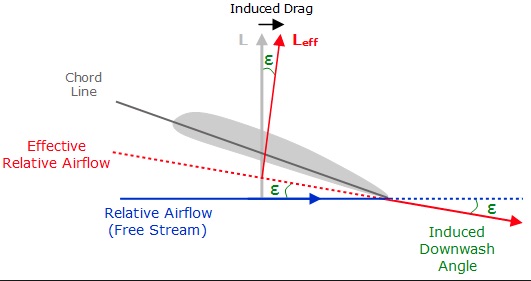The inflow becomes less vertical and also reduces in velocity since the pressure under the disk increases. The rotor airspeed is therefore reduced and induced drag reduces in proportion to the square of the reduced airspeed.
The tip vortices (recirculation) are also reduced meaning that the outer portion of the blade, where most of the lift is generated, becomes more efficient.
Since the angle of attack has reduced, because the inflow is more horizontal and the lift vector is now more vertical, you get more lift for the same pitch angle and therefore require less power.
Less power into the rotor = reduced induced drag.
This image, from Copters.com, may help.

To add some clarifications.
Why does the rotor effective airspeed reduce?
Imagine a helicopter in a zero wind, ideal conditions out of ground effect hover. The rotor, to produce lift, accelerates air downwards. Since there is no wind and the helicopter is not moving, the air is drawn into the disc from around it and mainly from above it. Ignoring side effects, the air is drawn down equally all around the disc. The airflow drawn into the disc has a horizontal component and a vertical component. The vertical component is large as there is little to stop the disc from pulling air down and accelerating it downwards. The speed of the rotor plus the horizontal component of the inflow co-incident with the average chord of the blade can be thought of as the "relative airflow".
Now imagine the same except hovering in ground effect. The cushion (increased pressure) below the disc reduces the inflow (imagine a fan partially blocked, the fan draws in less air) and thus the horizontal component of the inflow is reduced. Therefore, the relative wind airspeed is reduced. As you can see from the diagram solving the triangle of vectors, the angle of attack is also reduced. The collective could actually be reduced to accelerate the same amount of air. This power reduction results in a decrease in the induced drag.
Why does the same pitch angle produce more lift when hovering in ground effect?
The biggest "drain" of power when hovering, and the main reason why hovering uses more power than any other flight phase, is the vortices around the rotor tips and the outer third of the rotor where most of the lift is produced.
When hovering out of ground effect, there is nothing to stop the accelerating column of air under the disc from "escaping" and being drawn back up into the in-flowing air leading to re circulation and significant vortices. When hovering in ground effect, the air is forced to move out laterally from under the helicopter which effectively increases the radius of the vortices. There is a significant reduction in the turbulence around the tips and the outer third with a corresponding large increase in efficiency. Therefore, more lift is generated in ground effect than out of ground effect for the same angle of attack.
This can be seen practically by hovering over a hard surface and measuring power required then comparing this when hovering over long grass or worse, hovering over a dense standing crop. Since the long grass or crops reduce the ability of the air to escape further out laterally, the vortex radii are not increased as much as when hovering out of ground effect and more power is required.
It is possible, when there is little power in reserve, to be unable to take off vertically from long grass but be able to do so from the adjacent hard standing.
I think this video helps to visualise the vortices.





